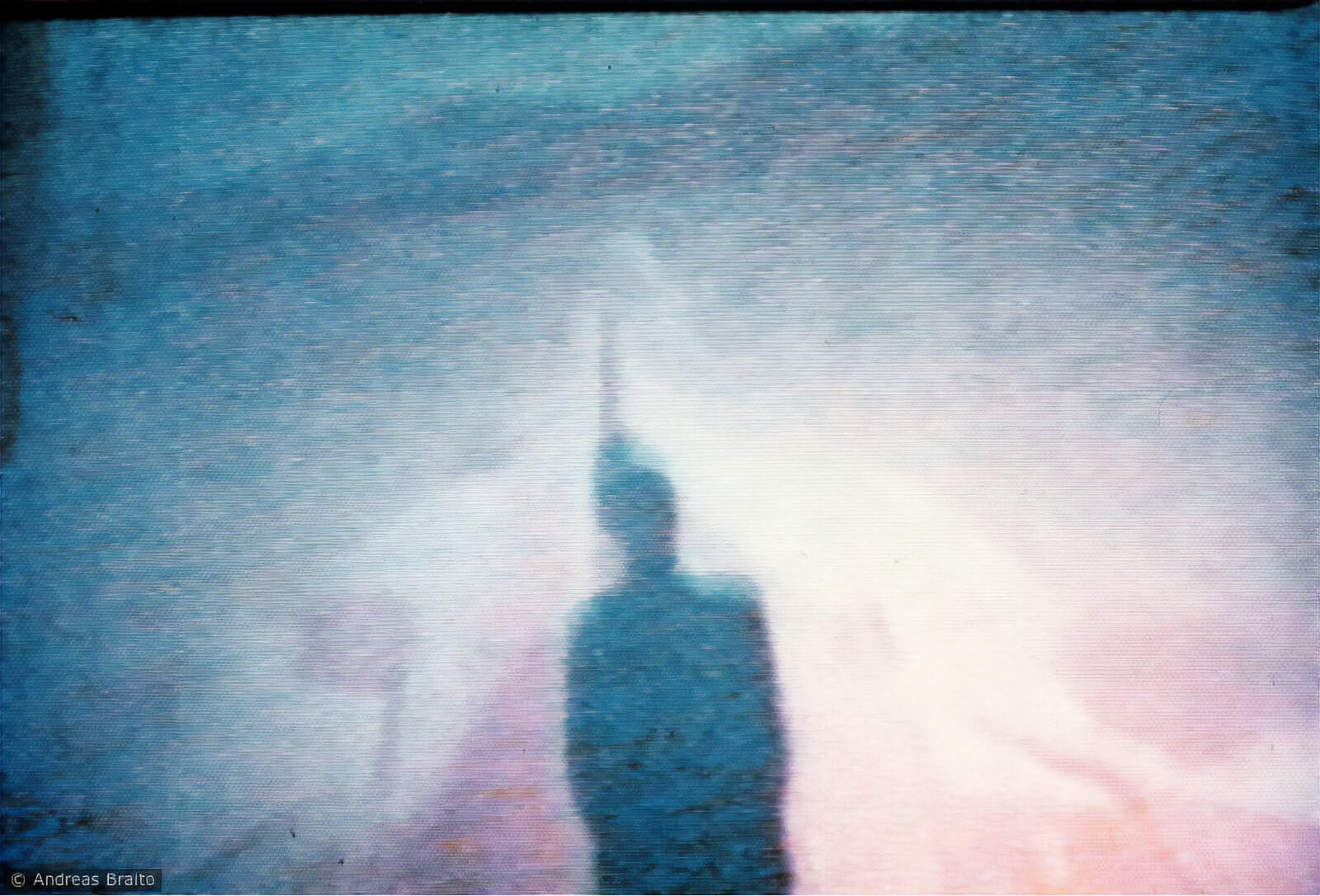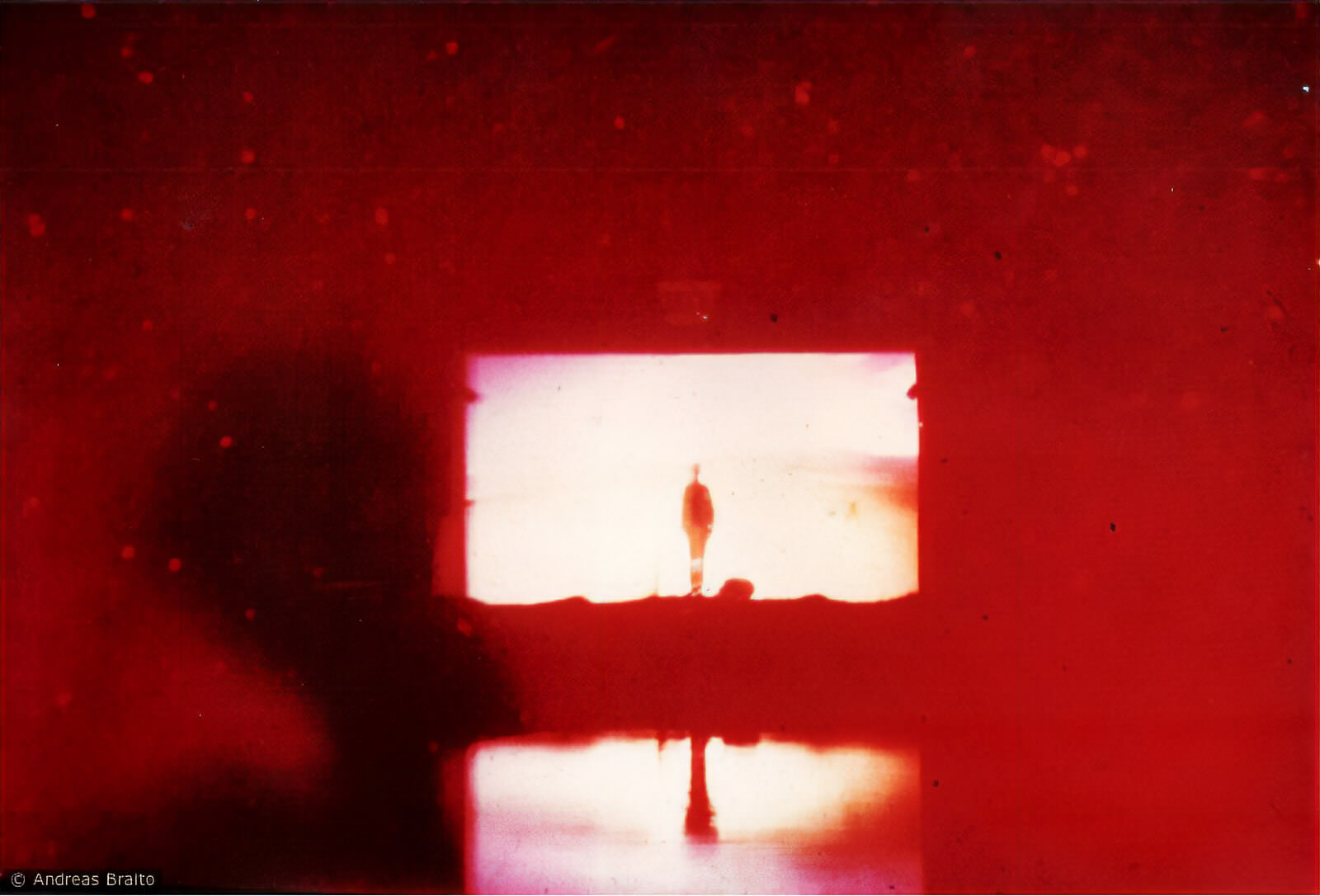Maelstromsüdpol
1987performative Installation by Erich Wonder, Heiner Müller, Heiner Goebbels
Documenta 1987
Ars electronica, Linz 1988
Landwehrkanal Berlin 1988
"Interspaces/After-images stories no longer tell themselves Erich Wonder As I have been concerned mainly with outward appearances by profession, pictures have always been significant points of reference as centres of friction of the apparently opposite, as places of refuge, as it were. The red room in the Hamburg exhibition "Inszenierte Räume", for instance, was a continuation of the red picture by Mark Rothko, was the step from painted space into the movement of a different time, the step from painted space into the narrative modes of "different" stories that can no longer be made visible by illustrative means.
Pictures — a gate for entering dreams, history, and imaginary voyages. Immersion in colour, colour as fictitious space, leaving everything behind, casting overboard the concept of "interpretation" as an outmoded, meaningless concept, colour tries to tell stories without making them conspicuously visible. Great stories are created in the minds and are not being illustrated.
Stories need to be seen. They are being told with fast "after-images", to be seen when eyes are being closed quickly after having been exposed to glaring light for some time. The "after- images" disappear gradually and take the viewer into dark, strange worlds. We dive with an imaginary submarine, we drop, we glide, float, dive into submerged cities, into spaces that cannot be painted, that create a third alternative beside a maximum of illusion and most extreme abstraction. Telling stories without interpreting them, a picture, a place, a flight, simultaneously, everything is possible — the viewer is not confronted with the "final solution"; he or she is included in the action, becomes part of the scene. The viewer must be able to see after a first few glances. It is the desire not to illustrate a theatre performance but to take up language and pictures and movement so as to go through it again in one's mind later, perhaps weeks later, and to experience this feeling of happiness. Inventing anew what has been heard, thought and seen before and living with it.
It is never the clear-cut lines that are interesting but the disruptions, the controversies, the reflections. Extreme opposites may produce something new, fresh, alternative — in one's mind. Extreme tension between maximal stillness and utmost movement turning into great deliberate stillness. Tarkowski's night trip in "Solaris", driving on highways in borderlands, consisting of continual immersion-emersion-immersion-emersion, the night flight through a thousand tunnels, through a thousand light wells, immersion in seas of light. Endless interplay of glaring light traps and extreme darkness. Never absolute daylight — never absolute darkness of the night. Monochrome rooms attempting to fly. Immersion in gloomy colour expanses — getting lost in them, wallowing in them. Dream or reality are no longer the question. Real stories are no longer the chief motif, they lodge in the interspaces. All that matters is the afterwards, the before, the inbetween. In this perfectly illustrated world the interspaces become increasingly significant and interesting. Places for anarchist fantasies.
So the borderland is the exciting field of the unvoiced, of "what has not yet been told to death". Stories can no longer be told as they were, once upon a time. There is no longer the story. Tales are told in fictitious movement. Reversals have more to tell than stubborn logic.
Exteriors become interiors. Interiors happen outside. Movement produces statics. Light produces darkness. A new reality. The viewer becomes creative part of the pictures, once immersed there is no escape, he or she sets out on a journey — a journey through and with rooms as movement. Rooms constantly changing themselves and their environment. Spatial movement as the consistent demolition of the once conceived aesthetic solution. A journey to escape from the ghetto of the frozen aesthetic moment. In the course of this journey a detail may be glimpsed that had not been seen before, a sequence may be formulated, the succession of possible details affirms the pluralism of insights and experiences, and realizing that there is no clear view we are taken to new aesthetic adventures. Stillness stimulates imagination — monochromy stimulates action — the quiet space of the night calls for high-power projection.
The apparently static picture is experienced as rotating space. The potential stillness arises only out of movement. Everything is possible on this journey, nothing may be true. Every attempt at uniformity and the quest for harmony pursued by many (artists?) is absurd and unrealistic. Genuine art today exists only in its contradiction.
To dig into the moving pictures at the moments of ultimate happiness and most profound misery to be challenged by them and to hide in them." (Erich Wonder)
Heiner Goebbels hat sich immer wieder mit Texten von Heiner Müller befasst. In dem Text „Maelstromsüdpol“ verarbeitet Heiner Müller Motive aus „Umständlicher Bericht des Arthur Gordon Pym zu Nantucket“ von Edgar Alan Poe. „Bei der akustischen Inszenierung dieser knappen Seite Text reizte mich (...) nicht die mehr oder weniger kunstvolle Verknüpfung, sondern die Entzerrung von Musik und Sprache, im Verhältnis Erlebnis/Beschreibung. Den Sog, von dem Arthur Gordon Pym in den antarktischen Katarakt gezogen wird, fest im Blick, konzentrierte ich mich auf die Arbeit mit einer Stimme.“
Texts
Malstrom (Review, de)
Noch ein Theater
8 June 1988, Die Zeit
Past Dates
September 1988
ars electronica
Donaulände & VOEST-ALPINE/Steelfactory, Linz (Austria)
June 1987
documenta, Kassel (Germany)

